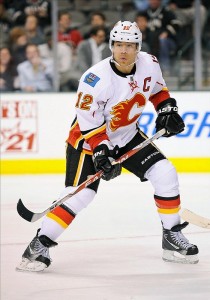
The 2013 season was one of change for the Calgary Flames. Veterans Jay Bouwmeester and Jarome Iginla were traded prior to the trade deadline, allowing the team to audition youngsters at the NHL level. In addition, the combination of Miikka Kiprusoff’s declining play with the widely-held belief that he’ll retire in the off-season may also allow the Flames to change their complexion.
When camp breaks in the fall, it’ll be the first training camp since 1986 without Joe Nieuwendyk, Theoren Fleury or Jarome Iginla. It’ll be the first camp in more than a decade without an established number one goaltender. It’ll also be the first camp in awhile without a well-cemented veteran leadership group – aside from perhaps holdover alternate captain Mark Giordano, generally considered the favourite in media circles to be the team’s next captain.
In addition to providing Calgary’s management with a tremendous opportunity to re-make the team in whatever image they see fit, the gulf of formal leadership on the roster may also provide a tremendous opportunity to change the culture of the team.
For over a decade, the primary on-ice leader of the Calgary Flames has been Jarome Iginla. If you’re a fairly established player coming to Calgary, when the going gets tough, you probably don’t speak up too loudly to rally the team – there’s a future Hall of Famer in the room who’ll probably do that. Similarly, the team has always had a slew of veteran blueliners – guys like Robyn Regehr or Jay Bouwmeester – who wore letters on their chests and had the respect of the room.
While that sounds great on-paper, the potential side-effects are that some established players don’t progress into leadership roles when they could have otherwise – there’s only so much time and space in the club’s ecosystem for so many vocal and non-vocal leaders – and that young players may hesitate to speak up at all.
As an example, take something as simple as Mikael Backlund and Sven Baertschi sitting in the Flames locker room across from Jarome Iginla. On one hand, they get to play and learn alongside a guy with as impressive a hockey resume as there is in the NHL. On the other hand, knowing that Iginla is an established leader in the locker room, they’re probably a bit less likely to speak up themselves. Considering how much of Iginla’s game was based on him being the team’s leader, it’ll be interesting not only to see who emerges as the leaders going forward for the Flames, but also whose game grows in different ways as a result of that emergence.
As an example, look at the recent play of Mikael Backlund, particularly late in the season. Backlund played with an edge to his game this season and, most memorably, he jumped in and fought Anaheim’s Ben Lovejoy following a knee-on-knee hit on teammate Curtis Glencross. A few months prior, you might have expected Iginla to be the guy stepping in for Glencross. Instead, it provided an opportunity for Backlund to step up and gain new experience.
For over a decade, the Calgary Flames have been Jarome Iginla’s team. Before that, throughout the 1990s, they were Joe Nieuwendyk and Theoren Fleury’s team. Before that, in the 1980s, they were a complete team with a diverse leadership group made up of names like Tim Hunter, Lanny McDonald, Joel Otto and Jim Peplinski. The departure of two of the team’s major established leaders creates a gulf in the team, but also provides a tremendous opportunity for the team and its players to find themselves and define the team for years to come.